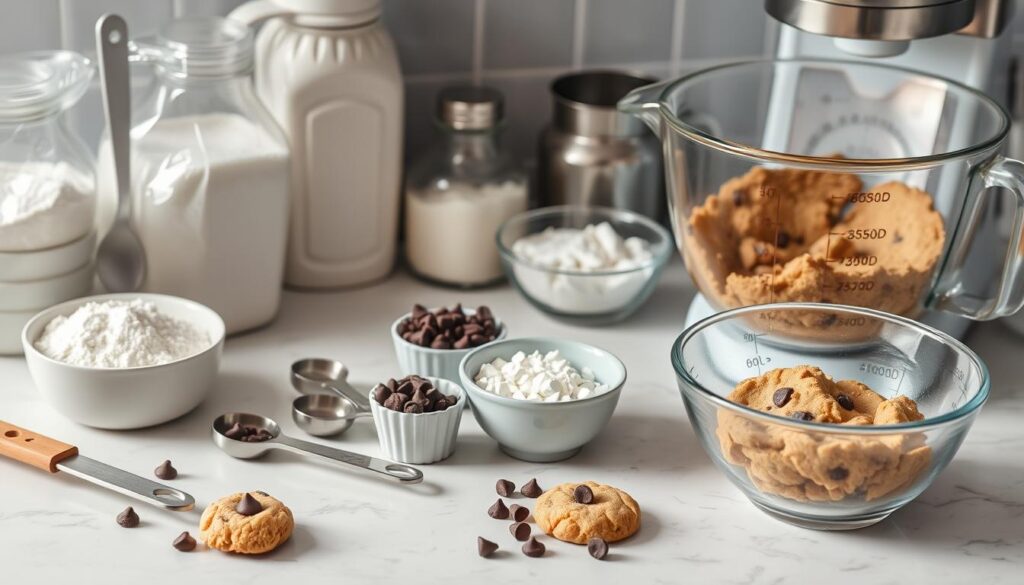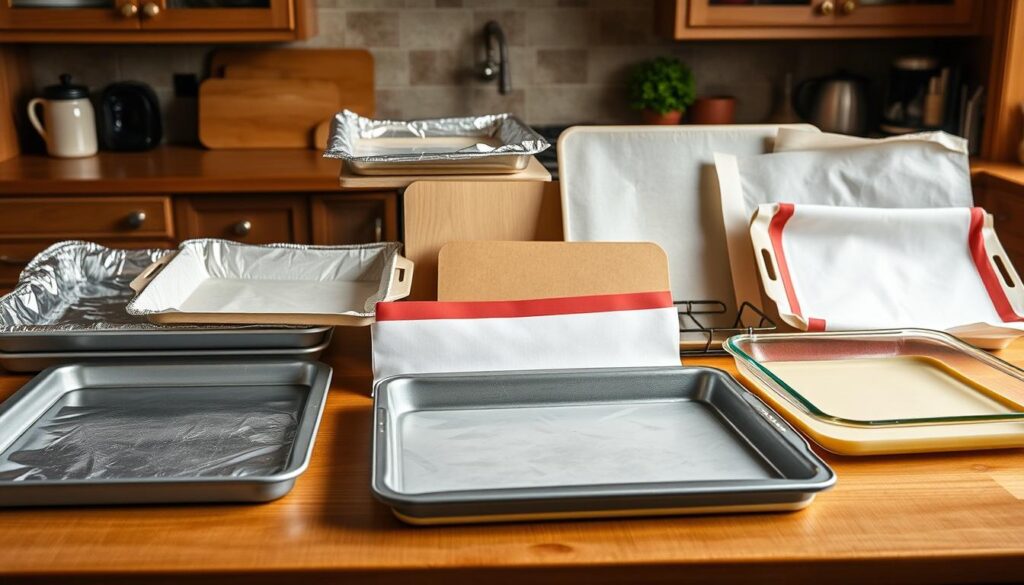If you love Nestlé Toll House chocolate chip cookies, you might have noticed they often turn out flat. This problem can be caused by many things, like temperature, the right mix of ingredients, and how you mix them. To get those perfect, fluffy cookies, you need to understand the science behind baking them.
Key Takeaways
- Proper temperature control, ingredient ratios, and mixing methods are crucial for preventing flat Nestlé chocolate chip cookies.
- The role of butter temperature in cookie spreading is a significant factor in achieving the desired texture.
- Chilling the cookie dough can have a profound impact on the final structure and appearance of the baked cookies.
- Baking surface and altitude adjustments can also influence the outcome of your Nestlé chocolate chip cookies.
- Following essential tips for perfect cookie texture, such as using the right baking sheets and monitoring oven temperature, can help you achieve baking success.
Common Causes of Flat Nestle Chocolate Chip Cookies
If your Nestlé chocolate chip cookies are flat, there are a few reasons why. Issues like temperature problems, wrong ingredient amounts, and mixing mistakes can cause this. Knowing these can help you make perfect cookies every time.
Temperature-Related Issues
Incorrect baking temperature is a big reason for flat cookies. Cookie spreading is greatly affected by the oven’s heat. Too hot, and cookies spread too much, becoming flat. Too cold, and they don’t spread enough, staying thick.
Ingredient Proportions
The ingredient ratios in your dough matter a lot. Too little flour compared to butter and sugar makes cookies spread too much. Too much flour makes dough stiff, stopping cookies from spreading right.
Mixing Techniques
Overmixing the dough can also make cookies flat. Over-mixing makes dough tough and dense. This stops cookies from spreading and rising as they should.
Fixing these issues with temperature, ingredient ratios, and mixing can help. Your Nestlé chocolate chip cookies will then be perfectly shaped and delicious.
The Role of Butter Temperature in nestle chocolate chip cookies Spreading
Getting the perfect Nestlé chocolate chip cookies starts with the butter’s temperature. The right butter consistency is key to a soft, chewy cookie. It’s the difference between a delicious treat and a dense one.
Softened butter is essential for the perfect cookie dough. It should be at room temperature before mixing. Melted butter, however, can make cookies too thin and flat.
- Softened butter keeps the dough light and fluffy, helping it hold its shape.
- Melted butter makes the dough too thin, causing cookies to spread too much.
- The best butter consistency is between softened and melted, still cool but spreadable.
Knowing how softened butter affects cookie dough texture helps bakers get the perfect cookie. It’s all about finding the right balance for that iconic Nestlé chocolate chip cookie.
“The temperature of the butter is the single most important factor in achieving the perfect Nestlé chocolate chip cookie texture.”
Understanding the Science Behind Flat cookies
Baking perfect cookies is more than just following a recipe. It’s about the science of cookie chemistry. This science affects the texture and look of your Nestlé chocolate chip cookies. By knowing the chemical reactions and physical changes in baking, you can avoid flat cookies.
Chemical Reactions During Baking

The magic of cookie chemistry happens with ingredients like flour, sugar, and butter. These ingredients change in the oven, shaping the cookie’s texture. Learning about these changes helps you get the right mix of flavors and textures.
Physical Changes in Dough Structure
When dough heats up, it changes in ways that can make cookies flat. The gluten in flour and how sugar crystallizes are key. Knowing these changes helps you avoid flat cookies.
Impact of Oven Temperature
The oven’s heat is crucial for your cookies. Too low, and they spread too much. Too high, and they cook unevenly. Finding the perfect oven temperature is key.
Exploring cookie chemistry, gluten development, sugar crystallization, and oven heat distribution helps you bake better cookies. This knowledge boosts your baking skills.
Proper Measuring Techniques for nestle chocolate chip cookies Success
To make the perfect Nestlé chocolate chip cookies, you need to measure ingredients accurately. Baking is all about precision. Even small changes in ingredient amounts can affect your cookies’ texture and structure. Learning how to measure correctly ensures your cookies always taste great.
A kitchen scale is a must for precise measurements. It’s better to weigh ingredients than to use measuring cups. This is crucial for ingredients like flour and butter, where small differences matter a lot.
- Invest in a high-quality digital kitchen scale for accurate measuring.
- For flour, sugar, and chocolate chips, measure by weight, not volume, for the best results.
- When using measuring cups, lightly spoon flour and level it off with a knife for the right ingredient ratios.
Using a scale is not the only thing you need to do. Proper measuring cup techniques are also key. Don’t pack ingredients too tightly in the cups. This can cause your cookies to spread too much or bake unevenly.
“Precise measurements are the foundation of baking success. Taking the time to ensure your ingredients are accurately portioned can make all the difference in the final result.”
By mastering measuring techniques, you’ll be on your way to baking perfect Nestlé chocolate chip cookies. Remember, paying attention to detail is crucial for the right texture and consistency.

The Science Behind Cookie Dough Chilling
Chilling the refrigerated dough is key to baking the best Nestlé chocolate chip cookies. This step greatly affects the cookie texture and the depth of flavors.
Optimal Chilling Time
The best chilling time for cookie dough is 24 to 72 hours. This long rest helps the fat solidify. As a result, the dough becomes more structured and less likely to spread when baked.
The longer it chills, the more flavors blend together. This leads to a richer, more complex taste in the cookies.
Effects on Cookie Structure
Chilling the dough also changes the cookie’s structure. As the fat solidifies, the dough spreads less. This makes the cookies thicker and chewier, with a better texture.
The dough’s structure also helps the cookies keep their shape while baking. They won’t flatten out as much.
“Chilling the dough is a simple yet crucial step in achieving the perfect Nestlé chocolate chip cookie. The science behind it ensures a better cookie texture and more flavor development.”
By understanding the science of cookie dough chilling, bakers can make their Nestlé chocolate chip cookies even better. They’ll get delicious, perfectly textured treats every time.
Impact of Different Baking Sheets and Surfaces
The type of baking sheet or surface you use can change how your Nestlé chocolate chip cookies turn out. The material and how well it conducts heat are key to getting the right cookie texture and spread.
Metal baking sheets are common and good at conducting heat. This can make the cookies spread fast and get crispy on the edges. But, the cookies might bake too quickly and become dry and thin.
Silicone baking mats are a good choice to stop cookies from spreading too much. They conduct heat less, so cookies bake evenly and keep their shape. Plus, they make it easy to take cookies off without breaking them.
Parchment paper works on any baking sheet and helps cookies spread less. It also makes cleanup easy. This makes it a great option for home bakers.
| Baking Surface | Heat Conduction | Cookie Spread | Texture |
|---|---|---|---|
| Metal Baking Sheet | High | Faster | Crisp edges, thin |
| Silicone Baking Mat | Low | Controlled | Softer, chewier |
| Parchment Paper | Moderate | Moderate | Balanced |
When baking Nestlé chocolate chip cookies, think about the baking surface’s impact. Choose the one that matches your cookie texture and spread goals. Knowing about different baking materials helps you get delicious results every time.

How Altitude Affects Your Nestlé Cookie Results
Baking Nestlé chocolate chip cookies at high altitudes can be tricky. The air pressure is lower, and moisture changes can affect your cookies. Knowing how to adjust for these changes is crucial for the perfect cookie texture, especially in mountainous areas.
High Altitude Adjustments
At high altitudes, you might need to make some changes:
- Up the oven temperature by 25°F to 50°F to bake cookies right.
- Cut down baking soda or powder by up to 25% to avoid cookies that rise too much.
- Add 1 to 2 tablespoons of flour per cup to make the dough thicker and stronger.
Moisture Content Changes
The air pressure at high altitudes also changes how cookies absorb moisture. To keep cookies moist and perfect:
- Add 1 to 2 tablespoons of liquid, like milk or eggs, per cup to balance the dryness.
- Try using a bit less sugar to stop cookies from getting too hard or dry.
- Chill the dough longer to help ingredients mix well and keep cookies moist.
With these adjustments, you can make Nestlé chocolate chip cookies that are just right, even at high altitudes.
Essential Tips for Perfect Cookie Texture
Getting the right texture in your Nestlé chocolate chip cookies is key to a great baking experience. You might love chewy cookies with crispy edges and soft centers. Or maybe you prefer a uniform, cakey texture. These tips can help you fix common problems and become a cookie baking pro.
First, making sure the butter is at the right temperature is important. Using room-temperature butter makes cookies spread out more and get crisper edges. On the other hand, chilled butter makes them thicker and chewier. Try changing the butter temperature to find your favorite cookie texture.
Also, measuring ingredients correctly, especially flour, is crucial. Too much flour makes cookies dry and cakey. Too little flour causes them to spread too much and become greasy. Use a kitchen scale and stick to the recipe’s measurements for the best results.
FAQ
Why do my Nestlé chocolate chip cookies go flat?
Several reasons can make Nestlé chocolate chip cookies flat. Issues like temperature, wrong ingredient amounts, and mixing methods are common. Knowing the science of baking is key to getting the right texture.
What are the most common causes of flat Nestlé chocolate chip cookies?
Flat cookies often come from temperature problems, wrong ingredient amounts, and bad mixing. Butter temperature, oven heat, and gluten can all affect how cookies spread and look.
How does butter temperature affect cookie spreading?
Butter’s temperature in the dough greatly affects cookie texture and spread. Soft or melted butter can make cookies spread too much, making them flat. Cool, firm butter is best to keep the dough’s structure during baking.
What is the science behind flat cookies?
Cookie baking is a science of chemical reactions and dough changes. Gluten, sugar, and oven temperature all influence cookie texture and shape. Knowing these can help fix flat cookies.
Why is precise measurement important for cookie success?
Measuring ingredients accurately is crucial for perfect cookies. Small changes in flour, sugar, butter, and other ingredients can greatly affect cookies. Using the right tools and techniques ensures the dough is just right for baking.
How does chilling cookie dough affect the final texture?
Chilling the dough is key to preventing cookies from spreading too much. As it chills, fat solidifies and gluten strengthens, helping cookies keep their shape. The right chilling time can make cookies chewier and more structured.
How do different baking surfaces and materials affect cookie spread?
The baking surface can change how cookies spread. The material of the sheet, using mats or paper, and the sheet’s color can all affect spread. This is because they influence heat transfer during baking.
How does altitude affect nestle chocolate chip cookies results?
Baking at high altitudes can be tricky due to air pressure and moisture changes. You might need to adjust ingredients, oven temperature, and baking time to get the right texture.
What are the essential tips for achieving the perfect nestle chocolate chip cookies texture?
For perfect Nestlé cookies, use the right butter, chill the dough, and measure ingredients accurately. Choose the best baking surface and adjust for high altitudes. Understanding baking science helps solve common issues and makes delicious cookies every time.

